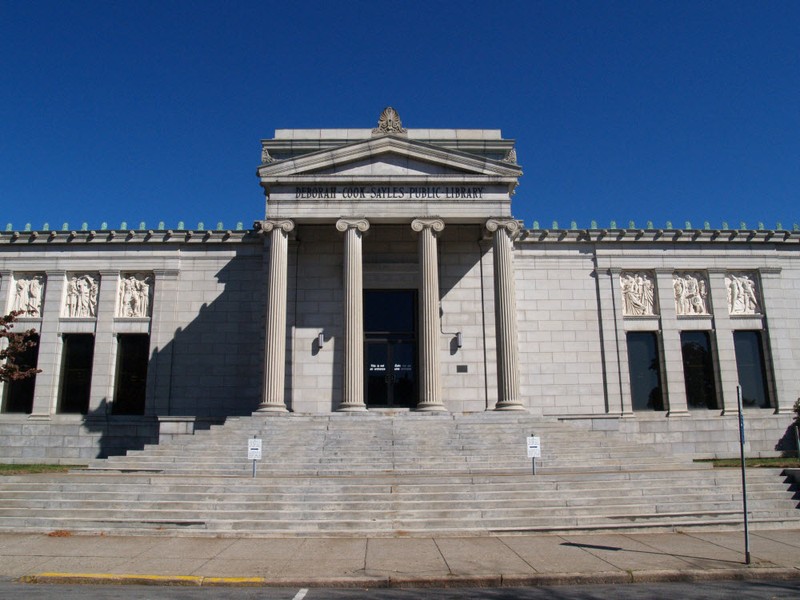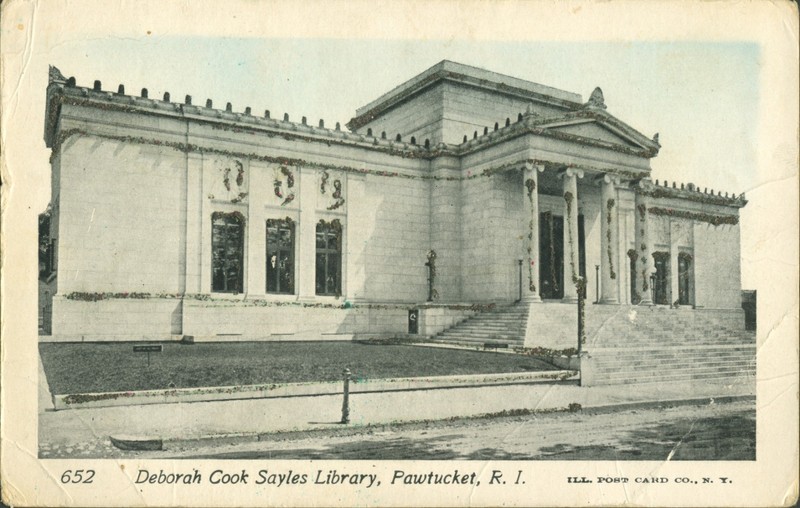Deborah Cook Sayles Library
Introduction
Text-to-speech Audio
Fredric Clark Sayles, the first mayor of Pawtucket, gifted the Deborah Cook Sayles Library to the city in 1898. After first providing the land, he traveled to Europe and sought architectural inspiration from Europe’s grand libraries. The builders laid the cornerstone on November 18, 1899, and the library opened to the public three years later on October 15, 1902, named for the mayor's late wife, Deborah Cook Sayles. The library is inspired by ancient Greek architecture and was renown for its progressive and permissive attitude towards patrons. While many libraries in the late 19th century were only accessible to subscribing members, this library operated under what was known as an "open shelf" policy. The library was also known for its policy of allowing children to use the library and hours of operation that included Sundays for to accommodate mill workers.
Images
Sayles Library Building

Pawtucket Library Postcard - Date Unknown

Backstory and Context
Text-to-speech Audio
Though this building was constrcuted at the turn of the century, the history of the Pawtucket Library Association dates back to its incorporation in February 1852 when the Pawtucket Library Association managed to raise $1,000 so it could purchase the local Freemasons library.
In 1876, the Town Council took control of the library and ownership of its book collection. The library gained notoriety for its progressiveness, notably instituting an "open shelf" system, allowing children under the age of 14 to use the library, and opening a Sunday reading room that permitted workers (who routinely worked Monday through Saturday) to enjoy the library.
Pawtucket grew as a mill town, benefiting financially from robust trade related to agriculture and industry during the second half of the 19th century. By the turn of the century, the city sought to develop the town beyond its role as a center of trade and growing industrial core. Partly for civic pride and also to counteract "sin behavior," this library and other civic institutions received the support of leading residents.As a result of founder Frederic Sayles' travels to Europe, the library was built using a design that stands as a striking example of Greek revival architecture. The library is comprised of fine-grained white granite and a large portico bounded by four massive columns at its former entrance. The front doorway of the building is an exact replica of the Erechtheion, a Greek temple on the Acropolis at Athens.
By the turn of the century, an increasing need, and desire, for a permanent building arose.
Pawtucket had gained a reputation as an industrial center, dating back to 1790 when Samuel Slater arrived and opened the first successful cotton mill in the United States (which also points to a time in the U.S. when cotton existed as a considerable portion of the U.S. economy). Thus, cotton helped Pawtucket achieve economic growth within the textile industry.
By the end of the nineteenth century, residents increasingly pushed to erect structures physically expressive of the town's prosperity, as well as provide leisure and beauty to its residents. Because, like many cities during the Industrial Revolution, libraries and other institutions served to bolster civic pride and instill a notion of an urban center maturing beyond its industrial core, often referred to as urban or civic boosterism (especially in analyzing western cities during that period). As well, progressives sought methods for which the "ills" of urbanization and industrialization could be curtailed, including providing an alternative to "sin behavior" such as spending time at taverns.
Hence, in 1890, the city celebrated the Cotton Centennial, and by the late 1890s, the library building emerged, serving both to enhance civic pride and enhance progressive ideals. In fact, at the dedication in 1902, Rev. George Harris said, "So this temple is dedicated to learning, to education, to the purest enjoyment of the people of Pawtucket, to promote the welfare of the city, to advance the interests of citizenship in an intelligent democracy."
Pawtucket had gained a reputation as an industrial center, dating back to 1790 when Samuel Slater arrived and opened the first successful cotton mill in the United States (which also points to a time in the U.S. when cotton existed as a considerable portion of the U.S. economy). Thus, cotton helped Pawtucket achieve economic growth within the textile industry.
By the end of the nineteenth century, residents increasingly pushed to erect structures physically expressive of the town's prosperity, as well as provide leisure and beauty to its residents. Because, like many cities during the Industrial Revolution, libraries and other institutions served to bolster civic pride and instill a notion of an urban center maturing beyond its industrial core, often referred to as urban or civic boosterism (especially in analyzing western cities during that period). As well, progressives sought methods for which the "ills" of urbanization and industrialization could be curtailed, including providing an alternative to "sin behavior" such as spending time at taverns.
Hence, in 1890, the city celebrated the Cotton Centennial, and by the late 1890s, the library building emerged, serving both to enhance civic pride and enhance progressive ideals. In fact, at the dedication in 1902, Rev. George Harris said, "So this temple is dedicated to learning, to education, to the purest enjoyment of the people of Pawtucket, to promote the welfare of the city, to advance the interests of citizenship in an intelligent democracy."
Cite This Entry
Powers, Mathew and Clio Admin. "Deborah Cook Sayles Library." Clio: Your Guide to History. October 12, 2018. Accessed August 14, 2025. https://theclio.com/entry/67538
Sources
Cumbler, John T. Reasonable Use: The People, the Environment, and the State, New England 1790-1930. New York: Oxford University Press, 2001.
"Fabric of Life in a Southern Mill Town: The Southern Mill Industry." William & Mary Center for Archaeological Research. https://www.wm.edu/sites/wmcar/research/danvilledig/history/southern-mill-industry/index.php
"History of the Library." Pawtucket Public Library. pawtucketlibrary.org. Accessed October 11, 2018. https://www.pawtucketlibrary.org/History.pdf
"History of the Library." Pawtucket Public Library. pawtucketlibrary.org. Accessed October 11, 2018. https://www.pawtucketlibrary.org/History.pdf
Morgan, Keith. "Nomination Form: Deborah Conk Sayles Public Library." National Register of Historic Places. Oct 2, 1975. https://npgallery.nps.gov/GetAsset/c129cfbd-9106-47bf-90e3-1bac17a0c244/
Photo Sources
Sayles Library Building: By Marcbela (Marc N. Belanger) - Own work, Public Domain, https://commons.wikimedia.org/w/index.php?curid=7231519
Pawtucket Library Postcard - Date Unknown - from http://www.pawtuckethistoryresearchcenter.org/
Photo Sources
Sayles Library Building: By Marcbela (Marc N. Belanger) - Own work, Public Domain, https://commons.wikimedia.org/w/index.php?curid=7231519
Pawtucket Library Postcard - Date Unknown - from http://www.pawtuckethistoryresearchcenter.org/

